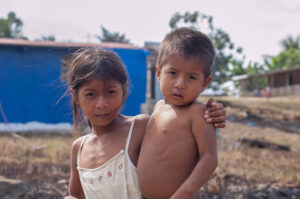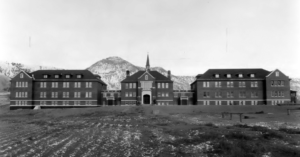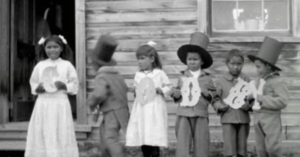Back in the 15th and 16th centuries, the Roman Catholic Church developed what came to be called the “Doctrine of Discovery,” based on the idea of European racial and cultural superiority. For centuries afterward, this doctrine served—whether directly or indirectly—as moral and legal justification for the colonial dispossession of sovereign Indigenous Nations in North America and elsewhere. This led the government of newly founded Canada to create a residential school program in the late 19th century. Its goal was to strip Canada’s Indigenous children of their culture and religion and integrate them into the dominant Settler society, but only as second-class citizens. Along with Canada’s government, its residential school program implicitly viewed Indigenous people as a problem to be corrected and solved.

In 2015 Canada’s Truth and Reconciliation Commission concluded that the residential schools were a system of cultural genocide. After mandatory attendance became law in the 1920s, many of the students were forcibly removed from their homes and any who ran away from the schools were harshly punished when caught. Of the 150,000 Indigenous children taken from their families and forced to attend residential school, many were shamed and treated harshly, and many were physically or sexually abused. While it is impossible to determine how many children died while in custody of the schools, the commission estimated that at least 4,100 Indigenous children died away from home, many due to negligence, disease, and abuse.[1]

The Canadian government opened one of its largest residential schools in 1893, on the outskirts of Kamloops, British Columbia. Like all the other residential schools, the Kamloops school subjugated, dehumanized, and exploited its students, dispossessing them of their most basic rights—including their right to speak their mother tongue.[2] Operated by the Catholic Church until 1969, the Kamloops school had a peak enrollment of 500 students in the 1950s. It was eventually run by the government directly before finally closed the school in 1978.
Given that the residential schools were inherently dehumanizing, it’s not surprising that conditions in the Kamloops school were always grim. One early principal complained that the government’s funding didn’t allow the administration to feed the students properly.[3] Seventeen years later, in 1927, a report acknowledged that the school buildings’ poor construction had led to “numerous infections, colds, bronchitis, and pneumonia.”[4] And in the 1950s, health officials acknowledged that the Kamloops school students had a higher-than-normal rate of influenza infection.[5]

Though they had no way to prove it, many First Nations people suspected that the Kamloops school had buried in unmarked graves any children who died in their custody. The question resurfaced when the remains of children were discovered on the school grounds—a tooth in the 1990s, a rib in 2000. This led Sarah Beaulieu, a University of the Fraser Valley anthropologist, to survey the site with ground-penetrating radar in 2021. Though she acknowledged that her findings could only be confirmed definitively by excavation and a forensic investigation, Beaulieu’s survey revealed what appeared to be 215 unmarked graves on the site, based on their depth, size, placement, and other features.[6] Until now the Secwepemc (Shushwap) tribe, on whose land the school stands, has withheld permission for such an investigation to proceed out of a desire to honor the dead by leaving their remains undisturbed.[7]
Predictably, news of Beaulieu’s discovery was met in Canada with a variety of responses:
- Many, myself included, were horrified and outraged to think that children who died after having been stolen from their parents by a genocidal government system had then suffered the dishonor and ignominy of being thrown into unmarked graves.
- Many Canadian politicians expressed shock and anger and made gestures—such as apologizing and flying flags at half-mast—meant to show respect to the children who had been so thoroughly disrespected, though many felt these gestures were mostly for show.
- The Pope humbly begged forgiveness for the deplorable ways the Catholic Church had wronged First Nations people. But to date the Canadian Catholic Church has not followed through on its financial commitments to righting the wrongs.
- To this day, too many Canadians refuse to accept Beaulieu’s findings. They seemingly cannot conceive of the fact that a school system that dehumanized all its students would mistreat the remains of those who died under their mistreatment.
Though I wish it didn’t, Beaulieu’s discovery makes perfect sense to me. Indeed, if her radar didn’t discover the bodies of the children who died while attending the school, where are their bodies? I am saddened to have some inkling of how badly Canada’s Settler society—of which I’m a part—treated Canada’s Indigenous peoples. And I’m truly shocked to think that I discovered this so late in life, thanks only to the Truth and Reconciliation Commission (TRC). I’m shocked that most Canadians had no knowledge of the existence of the Canadian residential school system before the TRC brought it to our attention (2007-15): it was, alas, Canadian government’s dirty little secret. I am pleased that our government and various other groups have taken some constructive actions in response to the TRC’s recommendations, but I’m saddened that we have not followed all of them.[8]
The church I’m a member of belongs to the Canadian Baptists of Western Canada (CBWC). While I’m relieved that the CBWC had no part in Canada’s residential schools, the residential school in Whitehorse, YT, was run by a different Baptist denomination, a denomination that no longer exists. This means the survivors of the Whitehorse school have no denomination they can hold accountable for the school’s legacy. My prayer is that other Canadian Baptist denominations, especially my own, will rise to the occasion and reimburse the Whitehorse school survivors on behalf of their fellow Baptists.
How I wish we could wave a magic wand to heal all the pain Settler greed and arrogance have caused our Indigenous sisters and brothers! But since no such wand exists, we must all simply speak out, call for change, and support our Indigenous neighbors as best we can. And we must pray for reconciliation and truth, which Jesus said is something we do, not just something we believe and talk about. It’s something we act upon–how we live. Only if we our words and deeds agree with his words and deeds can we truly call ourselves his followers.
[1] Paula Newton (May 29, 2021). “‘Unthinkable’ discovery in Canada as remains of 215 children found buried near residential school”
[2] Father Alphonse-Marie Carion, the school’s first principal, reported to the Department of Indian Affairs that the school’s goal was to “civilize the Indians, to make them good, useful and law-abiding members of society.” A.M. Carion, “Kamloops Industrial School, Kamloops, B.C., August 1, 1896”. Dominion of Canada Annual Report of the Department of Indian Affairs for the Year 1896. Department of Indian Affairs: 604–608.
[3] Kamloops Residential School Archived June 7, 2021, at the Wayback Machine. National Centre for Truth and Reconciliation, University of Manitoba
[4] Canada’s Residential Schools:Missing Children and Unmarked Burials (PDF). Montreal: Truth and Reconciliation Commission of Canada. 2015. ISBN 978-0-7735-4658-5.
[5] “City Free of Mass Flu Cases”. The Province (Vancouver: September 30, 1957) 19.
[6] Mike Hager, Jana G. Pruden, “Anthropologist explains how she concluded 200 children were buried at the Kamloops Residential School”. The Globe and Mail.
[7] “Work to exhume remains at former Kamloops residential school could begin soon, chief says”. Cbc.ca, May 31, 2022.
[8] https://www.rcaanc-cirnac.gc.ca/eng/1524494530110/1557511412801

